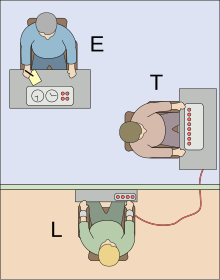Psychologia socialis



Psychologia socialis est studium scientificum modorum quibus cogitationes, sensus, moresque hominum praesentia aliorum moventur, sive vera sive animo ficta vel solum indicata.[1] Per hanc definitionem, vocabulum scientificum investigationem empiricam per rationem scientificam attingit; vocabula praeterea cogitationes, sensus, moresque psychologica attingunt variabilia quorum mensurae in hominibus fieri possunt. Dictum quod praesentia aliorum animo ficta vel indicata potest significat homines etiam soli exemplaria socialia respondent cum pelliculas vel programmata televisifica spectent, vel pelliculas musicas audiant, quia suaderi possunt ut mores visos vel internas normas culturales sequantur. Psychologi sociales usitate dicunt mores humanos esse exitum interactionum statuum mentis et rerum socialium.
Psychologia socialis psychologiam sociologiamque usitate coniungebat. Sub bellum mundanum secundum, annos 1940 exeuntibus, psychologi sociologique saepe adiutores erant.[2] Quae autem disciplinae magis magisque discrepant, sociologis magna variabilia sicut structuram socialem magis exprimentibus.
Periodica academica psychologiae sociali dicata
[recensere | fontem recensere]- Asian Journal of Social Psychology
- Basic and Applied Social Psychology
- British Journal of Social Psychology
- European Journal of Social Psychology
- Journal of Applied Social Psychology
- Journal of Experimental Social Psychology
- Journal of Personality and Social Psychology
- Journal of Social Psychology
- Personality and Social Psychology Bulletin
- Personality and Social Psychology Review
- Social Psychology
Nexus interni
- Theodorus Adorno
- Gordon W. Allport
- Albertus Bandura
- Convenientia
- Ducatus
- Effectus spectatorius
- Leo Festinger
- Ericus Fromm
- Curtius Lewin
- Georgius Herbertus Mead
- Stanleius Milgram
- Personalitas
- Praeconium mercatorium
- Praeiudicium
- Propaganda
- Psychologia cognitiva
- Psychologia turbarum
- Rhetorica
- Societas Psychologiae Socialis Europaea
- Sociologia
- Sociobiologia
- Sociophysiologia
- Socionica
- Stereotypus
- Gulielmus Wundt
- Philippus Zimbardo
Notae
[recensere | fontem recensere]Bibliographia
[recensere | fontem recensere]- Allport, Gordon W. 1985. "The historical background of social psychology." In The Handbook of Social Psychology, ed. F. Lindzey et E. Aronson. Novi Eboraci: McGraw Hill.
- Aronson, Elliot. 2008. The Social Animal. Ed. 10a. Worth Publishing.
- Aronson, Elliot, Timothy D. Wilson, et Robin M. Akert. 2010. Social Psychology. Ed. 7a. Novi Eboraci: Prentice Hall.
- Ambady, N., et R. Rosenthal. 1992. "Thin slices of expressive behavior as predictors of interpersonal consequences: A meta-analysis." Psychological Bulletin 111: 256–74.
- Asch, S. E. 1955. "Opinions and social pressure." Scientific American 31–35.
- Bandura, A., D. Ross, et S. A. Ross. 1961. "Transmission of aggression through imitation of aggressive models." Journal of Abnormal and Social Psychology 63: 575–82.
- Batson, C. D. 1998. "Altruism and prosocial behavior." In The handbook of social psychology, ed. .D. T. Gilbert, S. T. Fiske, et G. Lindzey. Novi Eboraci: McGraw Hill.
- Bem, D. 1970. Beliefs, attitudes, and human affairs. Belmont Californiae: Brooks/Cole.
- Bierbrauer, G. 2005. Sozialpsychologie. Ed. 2a. Grundriß der Psychologie, 15. Stutragdiae: Kohlhammer. ISBN 3-17-018213-7.
- Bless, H., K. Fiedler, et F. Strack. 2004. Social cognition: How individuals construct social reality. Hove Britanniarum Regni: Psychology Press. ISBN 0-86377-828-3.
- Borkenau, P., et A. Liebler. 1992. "Trait inferences: Sources of validity at zero acquaintance." Journal of Personality and Social Psychology 62: 645–47.
- Cialdini, R. B. 2000. Influence: Science and practice. Allyn and Bacon.
- Correll, J., B. Park, C. M. Judd, et B. Wittenbrink. 2002. "The police officer's dilemma: Using ethnicity to disambiguate potentially threatening individuals." Journal of Personality and Social Psychology 83: 1314–29.
- Cronbach, L. J. 1955. "Processes affecting scores on 'understanding of others' and 'assumed similarity.'" Psychological Bulletin 52: 177–93.
- Festinger, L., et J. M. Carlsmith. 1959. "Cognitive consequences of forced compliance." Journal of Abnormal and Social Psychology 58: 203–11.
- Fischer, P., K. Asal, et J. Krueger, eds. 2013. Sozialpsychologie für Bachelor. Heidelbergae: Springer. ISBN 978-3-642-30271-8.
- Frey, D., et S. Greif. 1997. Sozialpsychologie: Ein Handbuch in Schlüsselbegriffen. Ed. 4a. Weinheim: Beltz, Psychologie Verlags Union. ISBN 3-621-27219-4.
- Funder, D. C. 1995. "On the accuracy of personality judgment: A realistic approach." Psychological Review 102: 652–70
- Gergen, K. J. 1973. "Social psychology as history." Journal of Personality and Social Psychology 26: 309–20.
- Haney, C., W. C. Banks, et Philip G. Zimbardo. 1973. "Interpersonal dynamics in a simulated prison." International Journal of Criminology and Penology 1: 69–97.
- Heider, J. D., et J. J. Skowronski. 2007. "Improving the predictive validity of the Implicit Association Test." North American Journal of Psychology 9: 53–76.
- Higgins, E. Tory, and Arie W. Kruglanski, eds. 1996. Social psychology: handbook of basic principles. Novi Eboraci: Guilford Press. ISBN 1572301007.
- Janis, I. L. 1972. Victims of groupthink. Bostoniae: Houghton Mifflin Company.
- Jonas, K., W. Stroebe, et M. Hewstone, eds. 2014. Sozialpsychologie. Ed. 6a. Heidelbergae: Springer. ISBN 978-3-642-41090-1.
- Kenny, D. A. 1994. Interpersonal perception: A social relations analysis. Novi Eboraci: Guilford Press.
- Latane, B. 1981. "The psychology of social impact." American Psychologist 36: 343–56.
- Lipowatz, Thanops. 1998. Die Politik der Psyche: eine Einführung in die Psychopathologie des Politischen. Vindobonae: Turia & Kant. ISBN 3-85132-156-1.
- Mead, George Henry. 1927. Espíritu, persona y sociedad. Barcinonae: Paidós.
- Milgram, Stanley. 1975. Obedience to authority. Harper and Brothers.
- Moscovici, S., et T. Markova. 2006.The making of modern social psychology. Cantabrigiae: Polity Press.
- Orsini, Alcira. 2012. Psicología, una introducción. Bonaeropoli: AZ. ISBN 978-950-534930-2.
- Parygin, Boris. 1982. Grundlagen der sozialpsychologischen Theorie. Coloniae: Pahl-Rugenstein. ISBN 3-7609-0186-7.
- Perlman, D., et P. C. Cozby. 1985. "Percepción social." In Psicología social, ed. D. Perlman et P. C. Cozby. México: Mc Graw Hill.
- Perloff, R. M. 2003. The dynamics of persuasion. Mahwah Novae Caesareae: Lawrence Erlbaum.
- Sader, Manfred. 1996. Psychologie der Gruppe. Monaci: Juventa. ISBN 3-7799-0315-6.
- Sewell, W. H. 1989. "Some reflections on the golden age of interdisciplinary social psychology." Annual Review of Sociology 15L 1–17. doi:10.1146/annurev.so.15.080189.000245.
- Sherif, M. 1954. "Experiments in group conflict." Scientific American 195: 54–58.
- Sternberg, R. J. 1986. "A triangular theory of love." Psychological Review 93: 119–35.
- Stürmer, Stefan. 2009. Sozialpsychologie. Stutgardiae: UTB Basics. ISBN 978-3-8252-3179-8.
- Tajfel, H., et J. C. Turner. 1986. "The social identity theory of intergroup behavior." In Psychology of intergroup relations, ed. S. Worchel et W. G. Austin. Sicagi: Nelson-Hall.
- Tesser, A., et N. Schwarz, eds. 2001. Blackwell handbook of social psychology. Londinii: Blackwell Publishers. ISBN 978-0-631-21034-4.
- Triplett, N. 1898. "The dynamogenic factors in pacemaking and competition." American Journal of Psychology 9: 507–33.
- Vazier, S., et S. D. Gosling. 2004. "e-Perceptions: Personality impressions based on personal websites." Journal of Personality and Social Psychology 87: 123–32
- Watson, D. 1989. "Strangers' ratings of the five robust personality factors: Evidence of a surprising convergence with self-report." Journal of Personality and Social Psychology 57: 120–28.
- Werth, L., et J. Mayer. 2008. Sozialpsychologie. Spektrum Akademische Verlag. ISBN 9783827415479.
Nexus externi
[recensere | fontem recensere]
| Vicimedia Communia plura habent quae ad psychologiam socialem spectant (Social psychology (psychology), Social psychology). |
- Introduction to Social Psychology.
- Social Psychology Network.
- Social Psychology.
- Social psychology. PLOS
- Social psychology. Paginae datorum et fontium apud All-About-Psychology.Com
- Pelliculae
